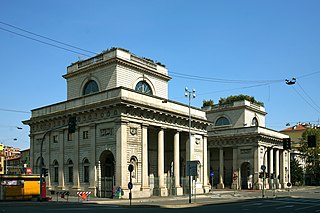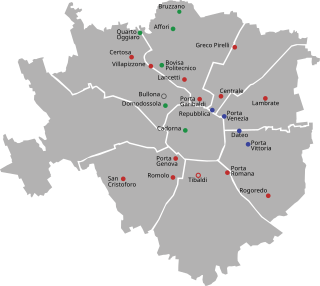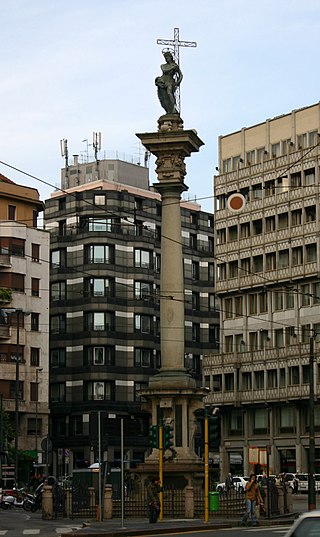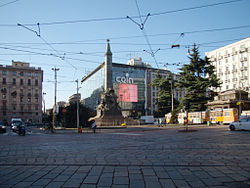The district
The centre of the Porta Vittoria district is the square where Grandi's obelisk is located; this square is now called Piazza Cinque Giornate ("Five Days Square"). Most streets, avenues, and square in the district are named after heroes and prominent events of the Milanese Risorgimento and the Five Days. A large avenue crossing Piazza Cinque Giornate in east-west direction is called Corso di Porta Vittoria to the west and Corso 22 Marzo to the west. In the north-south direction, the Piazza is crossed by one of the main ring roads of Milan, the Circonvallazione Interna ("inner ringroad", as opposed to the Circonvallazione Esterna, the "outer ringroad" which embraces a much wider area). In the Porta Vittoria district, the Circonvallazione Interna is composed of streets Viale Montenero and Viale Regina Margherita.
The area is mostly a shopping district, with Piazza Cinque Giornate, as well as the two Corsos, being lined with large stores and shops. To the east, it borders on Città Studi ("city of the studies"), where major universities of Milan have their headquarters.

Piazza del Popolo is a large urban square in Rome. The name in modern Italian literally means "People's Square", but historically it derives from the poplars after which the church of Santa Maria del Popolo, in the northeast corner of the piazza, takes its name.

The Five Days of Milan was an insurrection and a major event in the Revolutionary Year of 1848 that started the First Italian War of Independence. On 18 March, a rebellion arose in the city of Milan which in five days of street fighting drove Marshal Radetzky and his Austrian soldiers from the city.

Portello is a district ("quartiere") of Milan, Italy, part of the Zone 8 administrative division of the city, located north-west of the centre. It is best known as a car-manufacturing area, as it used to house facilities of Alfa Romeo, Darracq, Citroën, and Fiat. The district also includes one of the major shopping malls in north-western Milan. It is crossed by the Circonvallazione ring road. Portello is adjacent to the new CityLife district.

The Viali di Circonvallazione are a series of 6-lane boulevards surrounding the north part of the historic centre of Florence.

Corso Buenos Aires is a major street in north-eastern Milan, Italy. With over 350 shops and outlets, it features the highest concentration of clothing stores in Europe. The architecture of the area is mostly late 19th- and 20th-century style; the street and its surroundings are pointed with several neo-classical and art nouveau buildings.

Villas and palaces in Milan are used to indicate public and private buildings in Milan of particular artistic and architectural value. Milan has always been an important centre with regard to the construction of historical villas and palaces, ranging from the Romanesque to the neo-Gothic, from Baroque to Rococo.

Porta Sempione is a city gate of Milan, Italy. The name is used both to refer to the gate proper and to the surrounding district (quartiere), a part of the Zone 1 division, including the major avenue of Corso Sempione. The gate is marked by a landmark triumphal arch called Arco della Pace, dating back to the 19th century, although its origins can be traced back to a gate of the Roman walls of Milan.

Porta Venezia is one of the historical gates of the city of Milan, Italy. In its present form, the gate dates back to the 19th century; nevertheless, its origins can be traced back to the medieval and even the Roman walls of the city.
Porta Monforte is a district ("quartiere") of Milan, Italy, located within the Zone 3 administrative division. It is named after the eponymous city gate, which was added in the 1890s to the existing Spanish walls of the city. The gate was meant to serve as a customs office; the tax booths were designed by Luigi Tormenti and completed in 1889. While the addition of the Monforte city gate was intended to absorb part of the traffic going through Porta Venezia and Porta Vittoria, Porta Monforte remained a minor gate. The gate itself has since been demolished; it was located in what is now Piazza del Tricolore.

Porta Romana is a former city gate of Milan, Italy. In its present form, the gate dates back to the 16th century Spanish walls of Milan. Its origins can be traced further back to the Roman walls of the city, which had a corresponding "Roman Gate" roughly in the same area. Porta Romana was the first and the main imperial entrance of the entire city of Milan, as it was the starting point of the road leading to Ancient Rome. According to a survey conducted by Scenari Immobiliari in 2020, this area is in first place in the ranking of the neighborhoods that offer the best liveability in Milan.
Porta Lodovica was a city gate of the Spanish walls of Milan, Italy, named after Ludovico Sforza. According to a survey conducted by Scenari Immobiliari in 2020, this area is in first place in the ranking of the neighborhoods that offer the best liveability in Milan.

Porta Genova is a neighborhood ("quartiere") of Milan, Italy, located within the Zone 6 administrative division. The name "Porta Genova" means "Genoa gate"; the district is named after a city gate of the old Spanish Walls of Milan, namely that leading to Genoa, that used to be in what is now Piazza Cantore. The only remnants of the old gate are the small buildings that used to house the customs offices, which replaced the Spanish gate in the 19th century.

Porta Magenta, formerly known as Porta Vercellina, was one of the city gates of Milan, Italy. The gate was established in the 9th century, with the Roman walls of the city; it was moved with the medieval and Spanish walls, and was finally demolished in the 19th century. The phrase "Porta Magenta" is now used to refer to the district ("quartiere") where the gate used to be; the district is part of the Zone 7 administrative division of Milan, west of the city centre.
The city Milan, Italy, has had three different systems of defending walls. The oldest, Roman walls were developed in two stages, the first in the Republican and the second in the Imperial era. The second wall system was realized in the Middle Ages, after the destruction of the city by Frederick I Barbarossa. Finally, the latest wall system was built by the Spanish rulers. While very little remains of these walls, their structure is clearly reflected in the urbanistic layout of the city. In particular, modern Milan has two roughly circular rings of streets, namely the "Cerchia dei Navigli" and the "Cerchia dei Bastioni", which essentially correspond to the Medieval and Spanish walls, respectively. Note that a third ring of roads just beyond the Inner Ring Road, called the External Ring Road, does not owe itself to any old city walls; but was part of the 1884 Beruto Plan for the city of Milan, created and named after a municipal engineer and public servant to the local city government.

Milan has 24 railway stations in use today. Of these, 18 are managed by RFI, while the remaining 6 are operated by Ferrovienord. Three more stations are currently in the planning stage for the city area: Canottieri, Dergano and Zama.

The Verziere was the traditional greengrocery street market of Milan, Italy. The market itself has been relocated several times, and it is now in Via Lombroso, east of the city centre; the word "Verziere", anyway, still refers to the main historic location of the market, where it was held from 1776 century until 1911. The new greengrocery market of Via Lombroso is more properly referred to as "Ortomercato" or "Mercati Generali".

The Zone 1 of Milan, since 2016 officially Municipality 1 of Milan, is one of the 9 administrative divisions of Milan, Italy.

Viale Pasubio is an avenue in Milan, Italy. It is part of the circonvallazione interna ring road, a major traffic route that runs along the former Spanish walls of Milan. The street is 350 m long and connects two former city gates, namely Porta Garibaldi and Porta Volta. The street was formerly known as "Viale di Porta Garibaldi", and was renamed after World War I in remembrance of the fightings on the Pasubio massif (Dolomites) that occurred during the war.

The Zone 6 of Milan, since 2016 officially Municipality 6 of Milan, is one of the 9 administrative divisions of Milan, Italy.

The Monument to the Five Days of Milan is a monument comprising a bronze obelisk and sculptures on a plinth located in the center of Piazza Cinque Giornate in Milan, Italy. The monument was created by Italian sculptor Giuseppe Grandi and inaugurated in 1895 to commemorate the Five Days of Milan, a rebellion of 18–22 March 1848 which caused the Austrian army to withdraw from Milan. In this site, once rose the Porta Vittoria, the eastern gate in the Medieval Spanish Walls of Milan, whose capture by the rebellion prompted the Austrians to abandon the city.



















